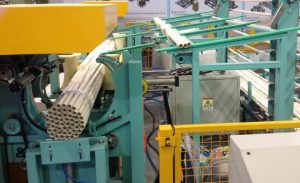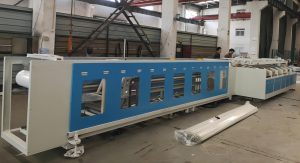Optimizing Plastic Pipe Packaging: A Guide to Bundling and Bagging Machines
Efficient handling and packaging are critical stages in plastic pipe manufacturing, directly impacting logistics, storage, and final product quality. Manual processes can be labor-intensive, inconsistent, and pose safety risks. Automated plastic pipe bundling and bagging machine systems offer a robust solution, streamlining operations from production line exit to shipment preparation.
What is a Plastic Pipe Bundling and Bagging Machine?

A plastic pipe bundling and bagging machine is specialized industrial equipment designed to automatically collect, group (bundle), and package plastic pipes, such as those made from PVC, HDPE, or other polymers. These machines enhance efficiency, ensure bundle consistency, reduce manual labor, and protect pipes during transit and storage.
Key Operational Steps and Components
Understanding the sequence and components involved clarifies how these machines achieve high throughput and reliable packaging:
Infeed and Alignment
Pipes typically arrive from the production line via conveyors. The machine's infeed system, often using guides, star wheels, or rollers combined with sensors and sometimes air jets, gently centers and orients each pipe correctly for the subsequent bundling process. Proper alignment is crucial for forming stable bundles.
Sorting and Ejection
Quality control is often integrated. Sensors may detect misaligned, damaged, or incorrect-sized pipes. Ejection components, such as pneumatic pushers or diverter gates, remove these non-conforming pipes from the line before bundling, preventing disruptions and ensuring consistent bundle quality.
Bundling Process
Once aligned and sorted, pipes are gathered into predetermined counts and configurations (e.g., hexagonal or square bundles). Mechanisms like rotating arms, collection flights, or indexing star wheels accumulate the correct number of pipes. The bundling interval and final bundle size are typically adjustable via the machine's control system to suit specific product requirements.
Packaging Options: Strapping, Wrapping, Bagging
After forming, the bundle is secured using one or more methods:
- Strapping: Automatic strapping units apply polyester (PET) or polypropylene (PP) straps around the bundle at set intervals. The straps are tensioned and sealed (often via heat or friction welding) to secure the pipes tightly.
- Shrink Wrapping: A layer of heat-shrinkable plastic film is applied around the bundle, often as a sleeve. The bundle then passes through a heat tunnel where the film shrinks tightly, providing containment and protection from dust and moisture.
- Bagging: Pipes are collected and dropped into pre-opened plastic bags held on a rack. Once filled, the bag may be sealed automatically. This method is common for smaller diameter pipes or specific customer requirements.
This video demonstrates a typical plastic pipe bundling and bagging machine in operation:
Control Systems
Modern machines utilize Programmable Logic Controllers (PLCs) for full automation, coordinating sensors, actuators, and motors. A Human-Machine Interface (HMI), typically a touchscreen panel, allows operators to set parameters (bundle size, strap tension, etc.), monitor operation, and troubleshoot issues. Simpler, more basic models might rely on mechanical timers and counters.
Handling Varying Pipe Lengths
A common challenge in pipe production is managing batches containing pipes of slightly different lengths. Automated bundling machines employ several strategies to accommodate this variability:
- Adjustable Length Tolerances: Machines can often be set to accept a certain degree of length variation within a single bundle, depending on the bundling mechanism and required bundle tightness.
- Overflow Conveyors: Pipes exceeding a preset maximum length for the current bundle configuration can be automatically diverted via an overflow conveyor system. These longer pipes might be collected for separate, potentially manual or semi-automatic, bundling.
- Multiple Bundle Size Programming: Some advanced systems can be programmed to create different standard bundle sizes or counts, potentially selecting the most appropriate configuration based on incoming pipe dimensions if equipped with adequate sensors.
- Rejection of Out-of-Spec Pipes: Pipes that are drastically shorter or longer than the acceptable range are typically rejected by the ejection system before entering the bundling section, preventing machine jams or unstable bundles.
The key is setting appropriate tolerance limits and bundle adjustments based on the specific production run and application requirements.
Benefits of Automated Pipe Bundling and Bagging
Implementing automated systems yields significant advantages:
- Increased Throughput: These machines operate continuously at speeds often ranging from 30 to over 200 pipes per minute (depending on pipe size and configuration), significantly outpacing manual methods.
- Reduced Labor Costs: Automation minimizes the need for manual handling, sorting, and packaging, freeing up personnel for other tasks.
- Improved Consistency: Automated processes ensure every bundle is formed and packaged to the same specifications, improving load stability and customer satisfaction.
- Enhanced Workplace Safety: Reduces risks associated with repetitive lifting and manual handling of potentially heavy or awkward pipe bundles.
- Minimized Product Damage: Gentle, controlled machine handling reduces scratches, dents, or other damage that can occur during manual packaging.
- Optimized Storage and Logistics: Uniformly bundled and packaged pipes are easier to stack, store in warehouses, and load onto transport vehicles.

automatic bundle bagging machine Considerations When Choosing a Machine
Selecting the right plastic pipe bundling and bagging machine involves evaluating several factors:
- Pipe Specifications: Required range of pipe diameters, lengths, and materials (PVC, HDPE, PP, etc.).
- Throughput Requirements: The necessary processing speed (pipes per minute or bundles per hour) to keep pace with production.
- Packaging Method: Strapping, shrink wrapping, bagging, or a combination? Consider material costs and protection levels needed.
- Bundle Configuration: Desired bundle size, shape (hexagonal, square), and count.
- Level of Automation: Need for PLC controls, HMI, integration with existing production lines or MES systems.
- Footprint and Layout: Available floor space and compatibility with the existing facility layout.
- Budget and Return on Investment (ROI): Initial investment cost versus projected savings in labor, efficiency gains, and reduced product damage.
Conclusion
Automated plastic pipe bundling and bagging machines are essential technologies for modern pipe manufacturers seeking to optimize their downstream operations. By efficiently sorting, bundling, and packaging pipes, these systems enhance throughput, ensure consistency, reduce labor dependence, improve safety, and protect product integrity. Carefully considering operational needs and machine capabilities allows fabricators to select equipment that provides significant returns through improved efficiency and streamlined logistics.
